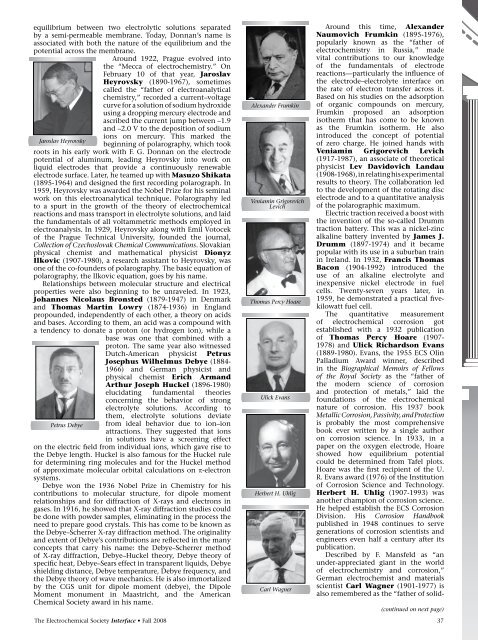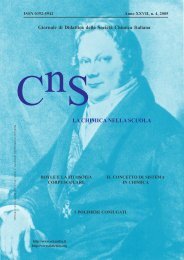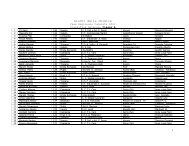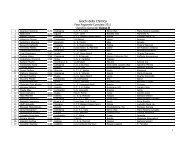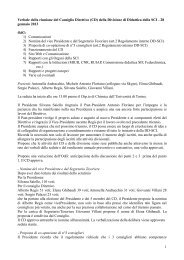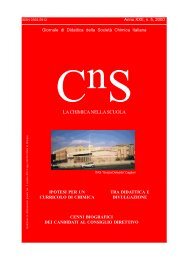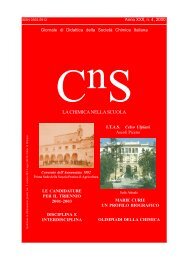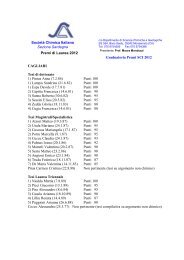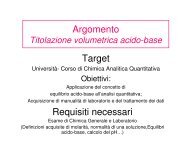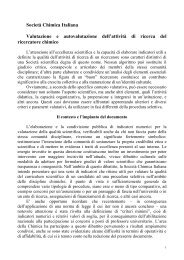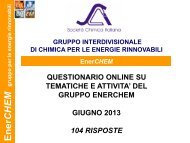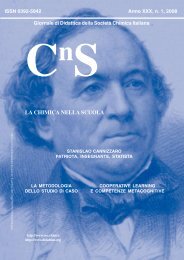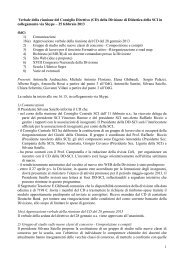ECS Classics - The Electrochemical Society
ECS Classics - The Electrochemical Society
ECS Classics - The Electrochemical Society
Create successful ePaper yourself
Turn your PDF publications into a flip-book with our unique Google optimized e-Paper software.
equilibrium between two electrolytic solutions separated<br />
by a semi-permeable membrane. Today, Donnan’s name is<br />
associated with both the nature of the equilibrium and the<br />
potential across the membrane.<br />
Around 1922, Prague evolved into<br />
the “Mecca of electrochemistry.” On<br />
February 10 of that year, Jaroslav<br />
Heyrovsky (1890-1967), sometimes<br />
called the “father of electroanalytical<br />
chemistry,” recorded a current–voltage<br />
curve for a solution of sodium hydroxide<br />
using a dropping mercury electrode and<br />
ascribed the current jump between –1.9<br />
and –2.0 V to the deposition of sodium<br />
Jaroslav Heyrovsky<br />
ions on mercury. This marked the<br />
beginning of polarography, which took<br />
roots in his early work with F. G. Donnan on the electrode<br />
potential of aluminum, leading Heyrovsky into work on<br />
liquid electrodes that provide a continuously renewable<br />
electrode surface. Later, he teamed up with Masuzo Shikata<br />
(1895-1964) and designed the first recording polarograph. In<br />
1959, Heyrovsky was awarded the Nobel Prize for his seminal<br />
work on this electroanalytical technique. Polarography led<br />
to a spurt in the growth of the theory of electrochemical<br />
reactions and mass transport in electrolyte solutions, and laid<br />
the fundamentals of all voltammetric methods employed in<br />
electroanalysis. In 1929, Heyrovsky along with Emil Votocek<br />
of the Prague Technical University, founded the journal,<br />
Collection of Czechoslovak Chemical Communications. Slovakian<br />
physical chemist and mathematical physicist Dionyz<br />
Ilkovic (1907-1980), a research assistant to Heyrovsky, was<br />
one of the co-founders of polarography. <strong>The</strong> basic equation of<br />
polarography, the Ilkovic equation, goes by his name.<br />
Relationships between molecular structure and electrical<br />
properties were also beginning to be unraveled. In 1923,<br />
Johannes Nicolaus Bronsted (1879-1947) in Denmark<br />
and Thomas Martin Lowry (1874-1936) in England<br />
propounded, independently of each other, a theory on acids<br />
and bases. According to them, an acid was a compound with<br />
a tendency to donate a proton (or hydrogen ion), while a<br />
base was one that combined with a<br />
proton. <strong>The</strong> same year also witnessed<br />
Dutch-American physicist Petrus<br />
Josephus Wilhelmus Debye (1884-<br />
1966) and German physicist and<br />
Petrus Debye<br />
physical chemist Erich Armand<br />
Arthur Joseph Huckel (1896-1980)<br />
elucidating fundamental theories<br />
concerning the behavior of strong<br />
electrolyte solutions. According to<br />
them, electrolyte solutions deviate<br />
from ideal behavior due to ion–ion<br />
attractions. <strong>The</strong>y suggested that ions<br />
in solutions have a screening effect<br />
on the electric field from individual ions, which gave rise to<br />
the Debye length. Huckel is also famous for the Huckel rule<br />
for determining ring molecules and for the Huckel method<br />
of approximate molecular orbital calculations on π-electron<br />
systems.<br />
Debye won the 1936 Nobel Prize in Chemistry for his<br />
contributions to molecular structure, for dipole moment<br />
relationships and for diffraction of X-rays and electrons in<br />
gases. In 1916, he showed that X-ray diffraction studies could<br />
be done with powder samples, eliminating in the process the<br />
need to prepare good crystals. This has come to be known as<br />
the Debye–Scherrer X-ray diffraction method. <strong>The</strong> originality<br />
and extent of Debye’s contributions are reflected in the many<br />
concepts that carry his name: the Debye–Scherrer method<br />
of X-ray diffraction, Debye–Huckel theory, Debye theory of<br />
specific heat, Debye–Sears effect in transparent liquids, Debye<br />
shielding distance, Debye temperature, Debye frequency, and<br />
the Debye theory of wave mechanics. He is also immortalized<br />
by the CGS unit for dipole moment (debye), the Dipole<br />
Moment monument in Maastricht, and the American<br />
Chemical <strong>Society</strong> award in his name.<br />
Alexander Frumkin<br />
Veniamin Grigorevich<br />
Levich<br />
Thomas Percy Hoare<br />
Ulick Evans<br />
Herbert H. Uhlig<br />
Carl Wagner<br />
Around this time, Alexander<br />
Naumovich Frumkin (1895-1976),<br />
popularly known as the “father of<br />
electrochemistry in Russia,” made<br />
vital contributions to our knowledge<br />
of the fundamentals of electrode<br />
reactions—particularly the influence of<br />
the electrode–electrolyte interface on<br />
the rate of electron transfer across it.<br />
Based on his studies on the adsorption<br />
of organic compounds on mercury,<br />
Frumkin proposed an adsorption<br />
isotherm that has come to be known<br />
as the Frumkin isotherm. He also<br />
introduced the concept of potential<br />
of zero charge. He joined hands with<br />
Veniamin Grigorevich Levich<br />
(1917-1987), an associate of theoretical<br />
physicist Lev Davidovich Landau<br />
(1908-1968), in relating his experimental<br />
results to theory. <strong>The</strong> collaboration led<br />
to the development of the rotating disc<br />
electrode and to a quantitative analysis<br />
of the polarographic maximum.<br />
Electric traction received a boost with<br />
the invention of the so-called Drumm<br />
traction battery. This was a nickel-zinc<br />
alkaline battery invented by James J.<br />
Drumm (1897-1974) and it became<br />
popular with its use in a suburban train<br />
in Ireland. In 1932, Francis Thomas<br />
Bacon (1904-1992) introduced the<br />
use of an alkaline electrolyte and<br />
inexpensive nickel electrode in fuel<br />
cells. Twenty-seven years later, in<br />
1959, he demonstrated a practical fivekilowatt<br />
fuel cell.<br />
<strong>The</strong> quantitative measurement<br />
of electrochemical corrosion got<br />
established with a 1932 publication<br />
of Thomas Percy Hoare (1907-<br />
1978) and Ulick Richardson Evans<br />
(1889-1980). Evans, the 1955 <strong>ECS</strong> Olin<br />
Palladium Award winner, described<br />
in the Biographical Memoirs of Fellows<br />
of the Royal <strong>Society</strong> as the “father of<br />
the modern science of corrosion<br />
and protection of metals,” laid the<br />
foundations of the electrochemical<br />
nature of corrosion. His 1937 book<br />
Metallic Corrosion, Passivity, and Protection<br />
is probably the most comprehensive<br />
book ever written by a single author<br />
on corrosion science. In 1933, in a<br />
paper on the oxygen electrode, Hoare<br />
showed how equilibrium potential<br />
could be determined from Tafel plots.<br />
Hoare was the first recipient of the U.<br />
R. Evans award (1976) of the Institution<br />
of Corrosion Science and Technology.<br />
Herbert H. Uhlig (1907-1993) was<br />
another champion of corrosion science.<br />
He helped establish the <strong>ECS</strong> Corrosion<br />
Division. His Corrosion Handbook<br />
published in 1948 continues to serve<br />
generations of corrosion scientists and<br />
engineers even half a century after its<br />
publication.<br />
Described by F. Mansfeld as “an<br />
under-appreciated giant in the world<br />
of electrochemistry and corrosion,”<br />
German electrochemist and materials<br />
scientist Carl Wagner (1901-1977) is<br />
also remembered as the “father of solid-<br />
(continued on next page)<br />
<strong>The</strong> <strong>Electrochemical</strong> <strong>Society</strong> Interface • Fall 2008 37


